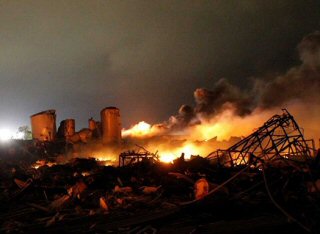SEJournal Online is the digital news magazine of the Society of Environmental Journalists. Learn more about SEJournal Online, including submission, subscription and advertising information.

The 15 deaths from an April 17, 2013, explosion of a fertilizer storage plant in the town of West, Texas, might serve as a reminder that such catastrophes can happen in many places — and that journalists can inform their communities of the hazards posed by materials that can explode, burn, poison, or otherwise harm them.
But will they? News stories so far have focused on the Texas plant operator's failure to completely disclose the risks it presented to federal or state authorities — as required by various rules and laws. They have focused less on the likely fact that government agencies knew the nature and magnitude of the hazard — or should have known. The bigger story is the regulatory failure — and industry's decades-long campaign to keep the public ignorant of the threats they face.
Texas, at least, had every reason to take the hazard of fertilizer explosions seriously. An ammonium nitrate fertilizer blast in 1947 at Texas City, TX, killed at least 581 people — the worst single industrial accident in US history. Despite this lesson, hazards remain, as was demonstrated in a 2001 fertilizer explosion in Toulouse, France, that killed 31.
While hazmat threats may sometimes be massive chemical plants, they are far more often likely to be mundane, everyday parts of life: a fertilizer dealer, a sewage or drinking water plant, a food refrigeration facility, an LP gas depot, a railroad siding, a maritime port.
Reporters have available to them tools for covering these threats. Under the 1990 Clean Air Act, Congress required facilities handling hazmats above a certain threshold to file "risk management plans (RMPs)." The requirement was not implemented for another decade. By 1999, under steady lobbying from the chemical industry and others, Congress changed its mind. Citing fears of terrorism, a 1999 amendment made that information very hard — but not impossible — for the public to get.
Reporters can theoretically get RMPs via EPA reading rooms and Local Emergency Planning Committees. The Right-to-Know Network has compiled them (or at least the unrestricted parts) into a public, online, searchable database. There are times when it can come in handy.
But RMP documents do slight good when they are incomplete, misleading, or inaccurate, as initially appears to be the case in the West, Texas, case. And they may stay that way unless government officials and journalists examine them and challenge the statements they contain.
This week, agents from the Bureau of Alcohol, Tobacco, and Firearms are still sifting through what local police were quick to call a "crime scene." But investigators from the Chemical Safety Board were also there — and the betting now is that it will prove an accident caused by neglect and ignorance rather than by terrorists. Some 10 of the 15 victims were first responders, mostly volunteer, who did not apparently understand the threat they faced or the need to evacuate. Without better media coverage and public understanding, communities may continue to locate hazmat facilities near schools, apartment buildings, and nursing homes (or vice versa), as was the case in West, Texas.
One requirement in federal law (part of the Emergency Planning and Community Right-to-Know Act that preceded the 1990 Air Act) is that communities have "emergency response plans" for incidents like that in Texas. During "Sunshine Week" in 2007, the Coalition of Journalists for Open Government, with help from the Society of Environmental Journalists, organized a "National Audit" in which reporters and volunteers asked local authorities for copies of the local plan. The law requires them to be disclosed — but only 44 percent of local authorities would give out their plans.
- "Texas Fertilizer Company Didn't Heed Disclosure Rules Before Blast," Reuters, April 20, 2013, by Joshua Schneyer, Ryan McNeill, and Janet Roberts.
- "REPORT: Cable News Ignores TX Fertilizer Plant's Regulation Violation," Media Matters, April 23, 2013, by Chelsea Rudman.
- "Why Didn't 2,400 Tons of Ammonium Nitrate at West Plant Raise Concerns?" Dallas Morning News, April 23, 2013, by Randy Lee Loftis.
- RTK NET: The Right-To-Know Network, Risk Management Plan Database.
- "St. Louis Fertilizer Plant Safety," KSDK St. Louis, April 22, 2013, by Ashley Yarchin.
- "In Years Before Waco Explosion, Fertilizer Trade Groups Lobbied for Lax Oversight," Sunlight Foundation Reporting Group blog, April 19, 2013, by Lindsay Young.
- "Local Agencies Don't Obey Law on Chemical Response Plan Disclosure," SEJ WatchDog of March 22, 2007, Society of Environmental Journalists.
- "The Sunshine Week 2007 National Information Audit: Comprehensive Emergency Response Plans," American Society of Newspaper Editors-Sunshine Week, Coalition of Journalists for Open Government, National Freedom of Information Coalition, and Society of Environmental Journalists, March 11, 2007. Press release of March 11, 2007, ASNE-Sunshine Week.
- Previous Stories: SEJ WatchDogs of March 25, 2009; May 13, 2009; May 7, 2009; April 30, 2008; January 10, 2007; and November 24, 2004.













 Advertisement
Advertisement 



